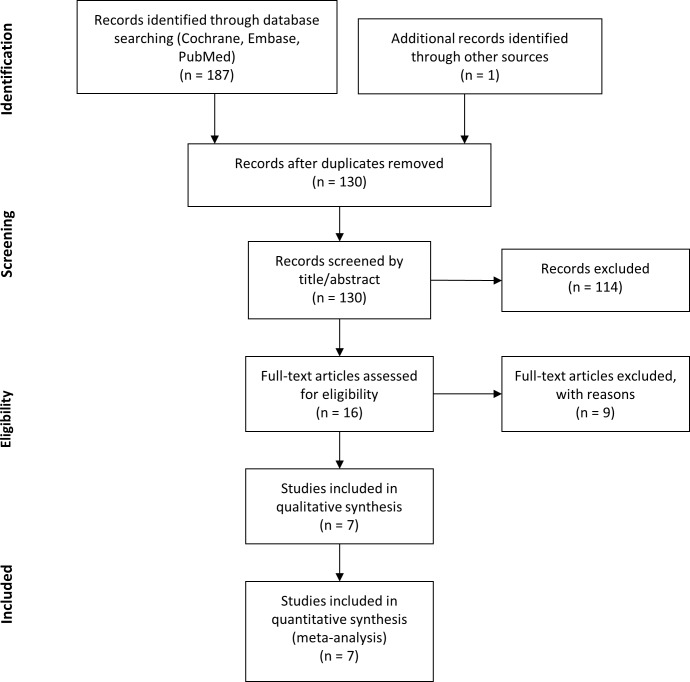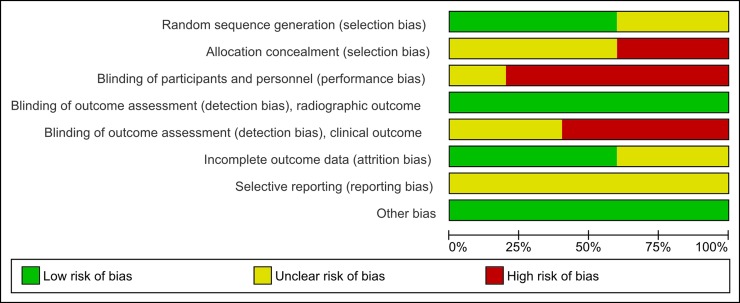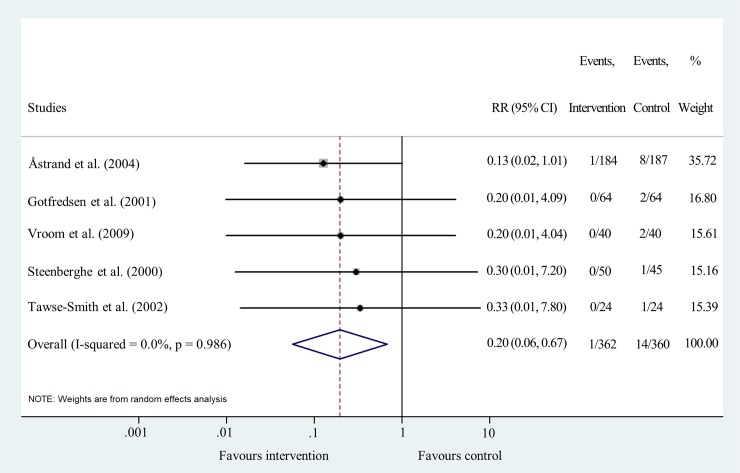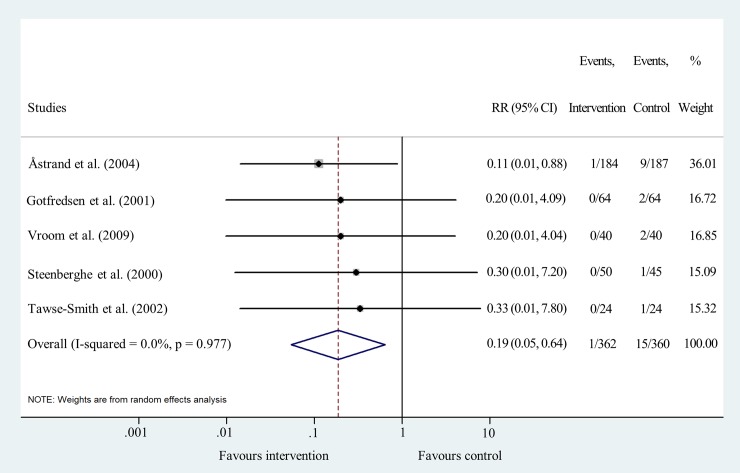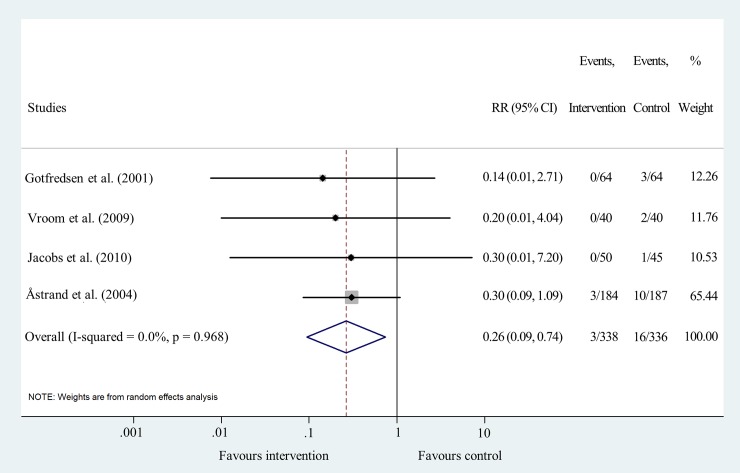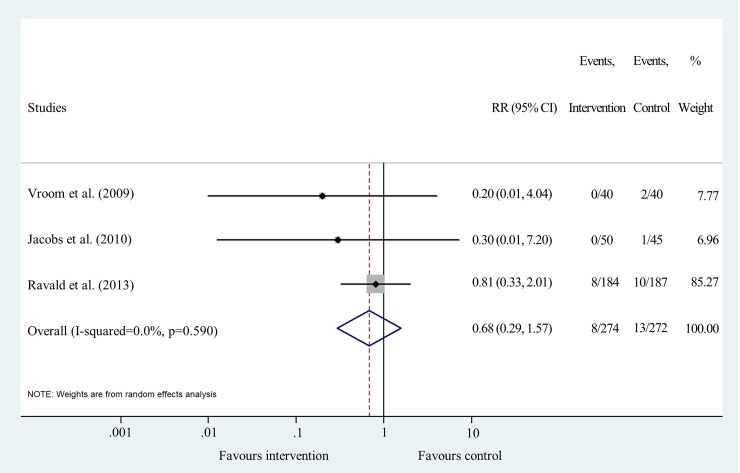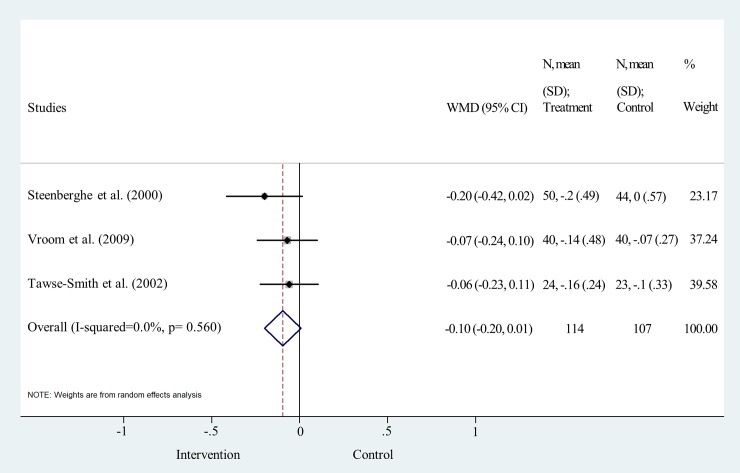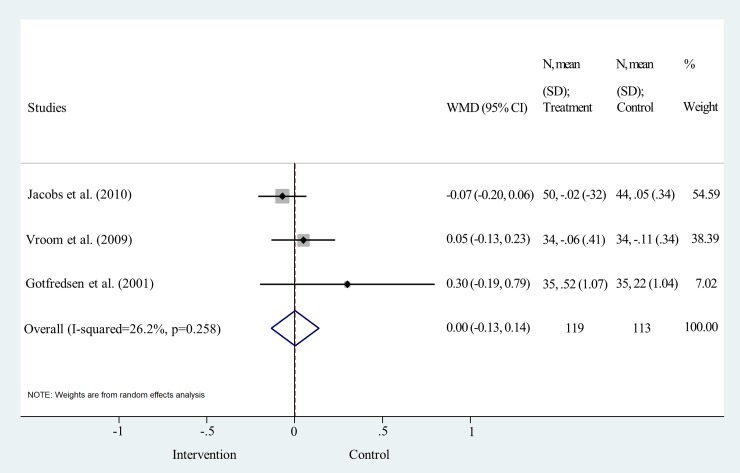Abstract
Introduction
Sandblasting is one of the oldest implant surface modifications to enhance osseointegration. Regarding its superiority over machined surface controversies still exist. Our objective was to compare implant failures (IF) and marginal bone level (MBL) changes between sandblasted and machined dental implants by a meta-analysis utilizing the available data. The PROSPERO registration number of the meta-analysis is CRD42018084190.
Methods
The systematic search was performed in Cochrane, Embase and Pubmed. Inclusion criteria included participants with neither systemic diseases, nor excessive alcohol consumption, nor heavy smoking. We calculated pooled Risk Ratio (RRs) with confidence intervals of 95% (CIs) for dichotomous outcomes (implant failure) and weighted mean difference (WMD) CIs of 95% for continuous outcomes (marginal bone level change). We applied the random effect model with DerSimonian-Laird estimation. I2 and chi2 tests were used to quantify statistical heterogeneity and gain probability-values, respectively.
Results
Literature search revealed 130 records without duplicates. Out of these, seven studies met the inclusion criteria and all were included in data synthesis, involving 362 sand-blasted and 360 machined implants. The results indicate that there is an 80% (RR = 0.2 95% CI:0.06–0.67; I2 = 0.0% p = 0.986) lower among sandblasted compared to machined implants after one year of use and 74% (RR = 0.26 95% CI:0.09–0.74; I2 = 0.0% p = 0.968) five years of use, respectively. In contrast, there is no significant difference in MBL (WMD:-0.10mm, 95% CI:-0.20, 0.01; p>0.05; I2 = 0.0%, p = 0.560 and WMD:-0.01mm, 95% CI:-0.12, 0.09; p>0.05; I2 = 26.2%, p = 0.258) between the two implant surfaces after one and five years of use.
Conclusions
This meta-analysis reveals that sandblasting is superior over machined surface in implant failure but not in marginal bone level in healthy subjects. It also points out the need for further randomized clinical trials with large sample size for objective determination of the clinical benefits of certain implant surface modifications.
Introduction
Since machined titanium dental implants were first used [1], enormous effort has been put into research to enhance osseointegration and increase the life span of implants. Many parameters have been identified that influence the period of healing time and bone stability [2–4].
It has been suggested that surface roughness is one of the several key factors influencing the degree of biological integration and success rates of inserted implants [5–7]. As a result of extensive investigation, several surface modifications have emerged. These include sandblasting, acid-etching, anodization, plasma-spraying, coating with different bioactive surfaces and the combination of these [5, 8]. Generally, implant surface roughness is modified by these processes. For roughness classification, four categories exist: smooth (Sa < 0.5 μm), minimally rough (Sa = 0.5–1 μm), moderately rough (1 μm < Sa < 2 μm) and rough implant surfaces (Sa > 2 μm) [9].
Sandblasting was one of the first modifications invented, resulting in moderately rough or rough surfaces, and it is still used by many implant manufacturers [4, 7]. During the blasting process, ceramic particles such as titanium oxide, aluminum oxide or silica [10] are blustered onto the implant surface at high velocity [11]. The size of sand particles and their speed when they reach the implant surface are the key parameters influencing surface roughness [8, 12]. The size of the particles usually varies between 25–250 μm [8, 13]. As a result, the surface becomes irregular with depressions and pits, and roughness (Sa) is between 1.2–2.2 μm [9, 14]. In contrast, machined surfaces are smoother, having only shallow grooves on the surface [8]. The roughness of a machined surface is usually between 0.5–1 μm [9].
Several in vitro studies have demonstrated the positive effects of sandblasted surfaces on osseointegration [7, 15, 16]. However, some preclinical and clinical investigations and reviews indicated that moderately rough surfaces may not perform better. These studies suggest that a rougher surface may modify the properties of biofilm formation and, therefore, bacteria could attach to the surface more easily [9, 16, 17]. Hence, the marginal bone around rough implants may be less stable [18] and more vulnerable to peri-implantitis [19, 20].
Although the attention and utilization shifted from machined to sandblasted surface, the scientific reason behind is not well-founded. In other words, for clinical practice, no clear and strong evidence exists to support the use of sandblasted implants over machined ones.
The RCTs investigating the effect of sandblasted implants applied relatively small sample sizes providing weak evidence. Conducting meta-analysis could overcome the weaknesses of the individual RCTs by increasing sample size and the validity of the statistical analysis Several review papers have been published on this topic[9, 20–22], which are, however, either not based on meta-analyses (because the authors, due to the great heterogeneity of the included studies, did not perform any) or even if they are, the meta-analyses performed combine all kinds of moderately rough surfaces. As an outstanding example, the most recent systematic review pooled together extremely heterogeneous studies, in which there were great differences in the study design. Thus, in addition to the results of RCTs, also those of uncontrolled trials and retrospective studies were combined in a single statistical analysis [20], thereby representing a very high level of bias. To our knowledge, no meta-analysis was performed involving exclusively RCTs, comparing the effect exerted on osseointegration by sandblasted implants with that exerted on it by machined implants. We assumed that identifying all relevant publications and conducting a meta-analysis might overcome the weaknesses of small sample size and increase the value of evidence in the topic.
The objective of the present meta-analysis and systematic review was to test the hypothesis that there are significant differences in implant failure rates and marginal bone level changes between sand-blasted and machined dental implants.
Materials and methods
Protocol and registration
This meta-analysis follows the PRISMA guideline [23]. The PRISMA checklist summarizing the content of this review is available in the supporting information (S1 Appendix).
The meta-analysis has been registered in Prospero (International Prospective Register of Systematic Reviews) database, 07/02/2018, registration number: CRD42018084190 (S2 Appendix).
Eligibility criteria
The PICO (patient characteristics, type of intervention, control and outcome) format was applied to the following clinical question: are there significant differences concerning implant failure rates and marginal bone level loss between machined and sandblasted dental implants among healthy patients?
For analysis, we considered records published in scientific journals compiling with our selected PICO. Patient characteristics: edentulous or partially edentulous participants who do not have any systemic diseases that would affect the osseointegration of implants. Type of intervention: treating tooth loss with endosteal dental implants, having undergone sandblasting surface modification. Control: treating tooth loss with endosteal dental implants, with machined surface (no surface modification). Outcome: the number of implants survived at each check-up, and changes in marginal bone level around the implants, which are measured using radiographic images.
Inclusion and exclusion criteria
Publications meeting the following eligibility criteria were included: 1) randomized controlled trials; 2) intervention: sandblasted implants; 3) control group: machined implants; 4) healthy participants; 5) similar implant designs. Records written in English or available in English translations. Exclusion criteria: 1) any publication type other than randomized controlled trials; 2) application of growth factors; 3) bone augmentation; 4) surface modification only on the implant neck; 5) participants with systemic or local conditions affecting osseointegration; 6) gray or black literature.
Information sources
A systematic search in English language limited to randomized controlled clinical trials was performed in three different major electronic databases (Cochrane Central Library, Embase and PubMed) with records published up to 20 August 2018. Besides electronic databases, an extensive hand search in the reference list of relevant articles and included records were also performed to find eligible records.
Search
The following research string, was used in the Cochrane database: “('machined':ti,ab,kw or 'turned':ti,ab,kw or 'blasted':ti,ab,kw or 'sandblasted':ti,ab,kw or 'sand-blasted':ti,ab,kw) and ('dental':ti,ab,kw or 'dentistry':ti,ab,kw) and 'implant':ti,ab,kw" with Cochrane Library publication date to Aug 2018, in Trials.
The following search string was used for finding records in Embase: “('machined':ti,ab,kw OR 'turned':ti,ab,kw OR 'blasted':ti,ab,kw OR 'sandblasted':ti,ab,kw OR 'sand-blasted':ti,ab,kw) AND ('dental':ti,ab,kw OR 'dentistry':ti,ab,kw) AND 'implant':ti,ab,kw AND 'controlled clinical trial'/de AND [english]/lim”.
The following string was used to search on PubMed: „(machined[Title/Abstract] OR turned[Title/Abstract] OR blasted[Title/Abstract] OR sandblasted[Title/Abstract] OR sand-blasted[Title/Abstract] OR sand blasted[Title/Abstract]) AND (dental[Title/Abstract] OR dentistry[Title/Abstract]) AND implant[Title/Abstract] AND (Clinical Trial[ptyp] AND ("0001/01/01"[PDAT]: "2018/08/20"[PDAT]) AND English[lang])”
Besides electronic databases, the reference lists of relevant articles were also searched.
Study selection
EndNote reference manger was used to organize and manage records. After removing duplicates, the remaining records were screened for suitability by two authors (L.M.Cz. and B.K.) based on the titles and abstracts of the published original papers. The eligibility of full texts of the remaining records was assessed by two reviewers independently (L.M.Cz. and B.K.). Disagreement between reviewers was resolved by discussion or, if it was necessary, by consulting with a third reviewer (G.V.).
Data collection process and data items
Data extraction was performed by two authors independently (L.M.C. and K.B.) using a preconstructed standardized data extraction form. The following information was extracted: first author’s name, year of publication, sample size, population type (type of edentulism), average age of participants, gender distribution, design of the studies, implant system for intervention and control, outcome (implant failure rate, marginal bone loss), conclusion of each study. In case of disagreement, a third author (G.V.) was also involved.
Risk of bias assessment
Quality and bias of the studies were evaluated according to the Cochrane Handbook [24], which is a broadly used guideline to assess randomized controlled trials. Studies were evaluated according to 8 domains. 1) Random sequence generation evaluates the strength of the method used for randomization. 2) Allocation concealment appraises the potential bias during allocation of the participants. 3) Blinding of participants and personnel assesses whether the patients and investigators were appropriately blinded to the treatment type. 4) Blinding of outcome assessment, radiographic outcome evaluates whether the personnel assessing x-ray images have been blinded. 5) Blinding of outcome assessment, clinical outcome appraises whether the clinical investigators evaluating the clinical outcome have been blinded. 6) Incomplete outcome data evaluate the risk of attrition bias due to withdrawals, loss of participants during follow ups and other missing data. 7) Selective reporting assesses whether all pre-determined outcomes have been measured and reported. 8) Other bias evaluates any other type of bias not falling into the previous 7 domains [24].
Summary measures and synthesis of results
Pooled Risk Ratio (RRs) with 95% confidence intervals (CIs) and weighted mean difference (WMD) with 95% CIs were calculated for dichotomous outcomes (IF) and for continuous outcomes (MBL change expressed in mm) respectively. Negative values in MBL change indicate a decrease in marginal bone level. Negative values of weighted mean differences indicate a greater decrease in MBL in sand-blasted implants compared to machined ones. Criteria for implant failure were defined according to Albrektsson et al. [25] Implant number was chosen as statistical unit. We only considered results credible if raw data for meta-analysis could be drawn from at least three records. We applied the random effect model with DerSimonian-Laird estimation. I2 and chi-square tests were used to quantify statistical heterogeneity and gain probability-values, respectively; p<0.1 indicated a significant heterogeneity. [24] All statistical analyses were performed using STATA 15.0.
Risk of bias across studies and additional analyses
Sensitivity analysis was performed by omitting studies (one by one) from the analyses and recalculating them in order to investigate the impact of the individual studies on the summary estimate. To check for publication bias, a visual inspection of funnel plots was performed.
Results
Study selection
During the study selection process, a total of 188 records were identified, including one record found in the reference list of related articles. After removing duplicates, 130 items remained. During the screening process, 114 records were excluded due to reasons such as other surface modification (n = 38) or different objectives (n = 76), investigating populations with systemic disease, evaluating surgical protocols, or comparing different macro designs of implants. For full-text evaluation 16 records were searched. Out of these publications nine records were excluded. The reasons for exclusion are explained below. Seven studies were eligible for qualitative and quantitative analysis [19, 26–31] (Fig 1).
Fig 1. PRISMA flow diagram of study selection process.
Study characteristics
Description of excluded studies
Out of the nine excluded records, three records were not eligible because of evaluating other surface modifications than the ones investigated in this meta-analysis [32–34]. Two studies reported on previous results of ongoing studies that have been republished in updated records [35, 36]. Two other records investigated different populations (periodontitis-susceptible) [37, 38]. One record was not RCT [39] and one other paper did not describe the surface modification used [40].
Description of the included studies
All involved studies were randomized controlled trials. A total of 722 implants (362 sandblasted and 360 machined) were included in the data synthesis. The populations represented in these studies were uniform, patients with alcohol and drug consumption or other medication abuse were excluded. Exclusion criteria also included bruxism, uncontrolled diabetes mellitus or any other significant medical condition that would affect the process of osseointegration. The mean age of participants in the studies varied between 50 and 58 years. In the five studies four different implant systems (Astra Tech, Brånemark, Steri-Oss and Southern Implants) were used. All implants in the control group had minimally rough surface and all implants in the intervention group had moderately rough surface [9].
All study groups except one [26] followed the two-stage protocol [41]. However, even in the study using one-stage protocol, implants were only loaded 3 months following healing at the lower jaw, and 6 months of healing at the upper jaw. Out of the five studies two [19, 26] treated edentulism with overdentures, another two [27, 30] used fixed partial bridges. One study [42] achieved rehabilitation with full arch bridges. The shortest follow-up was 2 years long, and the longest lasted for 16 years [29]. Each study provided information on implant failure rate and marginal bone level change calculated from blinded radiographic measurements. In one study [26], only two out of four groups were included, two groups using immediate loading protocol were not included in the analysis. Additionally, MBL measurements of Astrand et al. [31] and Ravald et al. [28]were excluded since the reported patient-based data could not be converted to implant-based data to match the statistics of other studies. A detailed description of these studies is shown in Tables 1 and 2.
Table 1. Summary of study characteristics.
| Author | Åstrand et al. (2004)andRavald et al. (2013)* | Gotfredsen et al. (2001) | Steenberghe et al. (2000) and Jacobs et al. (2010)* | Tawse-Smith et al. (2002) | Vroom et al. (2009) |
|---|---|---|---|---|---|
| Study type | block randomization separate for upper and lower jaw, with equal probability of receiving either implant type | alternating implant placement | split-mouth design | random allocation to either implant system on a one-by-one basis | alternating implant placement |
| Country | Sweden | 4 Scandinavian countries | Belgium | New Zealand | not stated |
| Age | = 61.5 | = 53 | = 59.7 | 55–80 | = 53 |
| Number of participants | males: 28, females: 38 | males: 25, females: 25 | males: 6, females: 12 | total: 48 | males: 7, females: 13 |
| Extent of teeth loss | edentulous | partially edentulous | partially edentulous | edentulous (mandible only) | edentulous (mandible only) |
| Sand-blasted implant (intervention) | Astra Tech implants | Astra Tech implants | Astra Tech implants | Southern Implants | Astra Tech implants |
| Machined implants (control) | Branemark System MK II | Astra Tech implants | Branemark System MK II | Sterioss | Astra Tech implants |
| Surgical protocol | two-stage technique (3 months and 6 months healing in the lower and upper jaw respectively before abutment placement | two-stage technique (3–4 months and 6–7 months healing in the lower and upper jaw respectively before abutment placement | two-stage technique (3–4 months and 6–7 months healing in the lower and upper jaw respectively before abutment placement | one-stage technique (3 months of healing before loading) | two-stage technique (3–4 months healing before abutment placement |
*The publications of Ravald et al (2013) and Jacobs et al (2010) are the continuations of the studies published by Åstrand et al (2004); and Steenberghe et al (2000) respectively.
Table 2. Summary of study characteristics.
| Author | Åstrand et al. (2004) and Ravald et al. (2013)* | Gotfredsen et al. (2001) | Steenberghe et al. (2000) and Jacobs et al. (2010)* | Tawse-Smith et al. (2002) | Vroom et al. (2009) |
|---|---|---|---|---|---|
| Type of prosthesis | full-arch fixed bridges | screw retained fixed partial prosthesis | screw retained fixed partial prosthesis | implant supported overdenture | implant supported overdenture |
| Outcome | IF, MBL change, BOP, plaque accumulation, pain, suprastructure complications | IF, MBL change, BOP, paraesthesia, periimplant inflammation, pain, suprastructure complications | IF, MBL change, sulcus bleeding index, PPD presence of plaque | IF, MBL change, sulcus bleeding index, PPD, implant stability measurement (Periotest), modified plaque index | IF, MBL change, bleeding index. PPD, presence of calculus |
| Follow-up time | 5 and 12*years | 5 years | 2 and 15*years | 2 years | 12 years |
*The publications of Ravald et al (2013) and Jacobs et al (2010) are the continuations of the studies published by Åstrand et al (2004); and Steenberghe et al (2000) respectively.
IF: implant failure
MBL: marginal bone level
BOP: bleeding on probing
PPD: probing pocket depth
Risk of bias within studies
Bias in the studies was assessed according to the Cochrane Risk of Bias Tool. All seven included studies were included in the risk of bias assessment, however two pairs of studies [28, 31] and [27, 29] were evaluated together because the study of Ravald et al [28] and Jacobs et al. [29] are the continuation of previous studies of Åstrand and coworkers [31] and those of Steenberghe and coinvestigators [27], respectively.
Two studies [26, 27] had unclear random sequence generation, and other two [19, 30] had a high risk of allocation concealment, due to the predictable sequence generation process used. All studies performed blinding during the evaluation of x-ray images. However, due to its nature, no blinding could be carried out evaluating the implants clinically. Dropouts were identified in four studies [19, 26, 30, 31], two of these with unclear risk of bias.[19, 26]. Access was not gained to study protocols or trial registers, however, no intext evidence of selective reporting was found. Fig 2, S1 Table and S3 Appendix contain the summary of the risk of bias assessment.
Fig 2. Risk of bias graph. Percentage of each risk of bias item across included studies.
Results of individual studies and synthesis of results
Sandblasted implants are better than machined implants concerning implant failure at 1, 2 and 5–6 years
Data for implant failure analysis after one year were pooled from five studies [19, 26, 27, 30, 31]. The results show that there is an 80% lower risk for sand-blasted implants to fail compared to machined implants after one year of use (RR = 0.20 95% CI: 0.06–0.67; I2 = 0.0% p = 0.986) (Fig 3 and S1 File).
Fig 3. Forest plot analysis of implant failure rate after one year.
Data for cumulative implant failure after two years could be pooled from five studies [19, 26, 27, 30, 31]. The meta-analysis revealed that the risk of sand-blasted implant failure is 81% lower than that of machined implants (RR = 0.19 95% CI: 0.05–0.64; I2 = 0.0% p = 0.977) (Fig 4 and S1 File).
Fig 4. Forest plot analysis of cumulative implant failure rate after two years.
Data for analyzing the effect of sandblasting on implant failure after five or six years’ follow-up were pooled from four studies [19, 29–31]. The results indicate that there is a 74% lower risk of sandblasted implants to fail (RR = 0.26 95% CI: 0.09–0.74; I2 = 0.0% p = 0.968) (Fig 5 and S1 File).
Fig 5. Forest plot analysis of cumulative implant failure rate after 5/6 years.
Results for cumulative IF after 12–15 years were synthesized from 3 studies [19, 28, 29]. Results show that there is no significant difference between the two treatment types (RR = 0.68 95% CI: 0.29–1.57; I2 = 0.0% p = 0.590) (Fig 6 and S1 File).
Fig 6. Forest plot analysis of cumulative implant failure rate after 12/15 years.
No detectable difference in MBL between sand-blasted and machined implants after 5 years of follow up
MBL change was analyzed one and five years after the delivery of the final prosthesis One-year data were pooled from three studies [19, 26, 27]. No significant difference was found between the two surface treatments, (weighted mean difference = -0.10, 95% CI: -0.20–0.01; p>0.05; I2 = 0.0%, p = 0.560) (Fig 7 and S1 File). Data for 5-year analysis were pooled from three studies [19, 29, 30]. The statistical analysis clearly shows that the difference is not significant between the two implant surface types, the line of null effect falls within the range of the confidence interval (weighted mean difference = 0.00, 95% CI: -0.13–0.14; p>0.05; I2 = 26.2%, p = 0.258) (Fig 8 and S1 File).
Fig 7. Forest plot analysis of marginal bone level change after one year.
Fig 8. Forest plot analysis of marginal bone level change after 5 years.
Risk of bias across studies and additional analysis
Funnel plot analyses indicated a moderate level of publication bias (S4 Appendix). Statistical heterogeneity was not important in the results of IF at all time points. I2 values were 0.0% and p values varied between 0.590 and 0.986 (Figs 3, 4, 5 and 6). Heterogeneity was also negligible in the results of MBL change at 1 year (I2 = 0.0%, p = 0.560) (Fig 7). I2 (26.2%) and p (0.258) values indicated a slightly higher level of statistical heterogeneity for the results of MBL change at 5 years (Fig 8), however, this was still considered insignificant. [24].
Sensitivity analysis showed that the removal of the study of Astrand et al. [31] decreases the significance of the results of pooled risk ratio analysis at one, two and five/six years following implantation. This is most likely due to the large sample size of that study compared to the other RCTs.
Discussion
Summary of evidence
As a result of extensive investigations conducted in the past decades, several methods for implant surface modifications have emerged and numerous studies claimed superiority for one or other roughened surfaces. [43–45] However, no evidence supports a single decisive hypothesis. Therefore, the contradictory conclusions of the literature require further studies and careful re-analysis. As our objective stated, we re-evaluated the performance of sand-blasted implant surface over machined ones. To obtain the highest level of evidence, a meta-analysis was conducted including only RCTs available on the topic but excluding uncontrolled trials and retrospective studies. Implant stability was evaluated by measuring MBL changes and comparing cumulative implant failure rates. After appropriate selection, seven RCTs, 202 patients, having 362 sand-blasted and 360 machined implants could be included in our complex approach.
Our meta-analysis revealed that implant failure rates were significantly different between machined implants and sand-blasted ones. In contrast, the results of the individual RCTs could not reveal a significant difference between the two types of surfaces. This gained difference reflects the increased number of samples and the high power of statistical methods of meta-analysis. Most implant failures happened during the first year after implantation. The reason for this could be that the surface modification of sandblasted implants creates a rougher surface which enhances the processes of bone formation on the implant itself. [46] Independent researchers published similar observations on other moderately rough surfaces, too. [47] Our results also show that after one year, when osseointegration has already taken place, the difference between the two surfaces diminish and the significance of the difference between implant failures disappear. Additionally, a histological study, using small sample size, also confirmed that, in the long term, both implant types maintained a decent level of osseointegration. It was found that after 5 years the bone-implant contact level was 92.7% for machined and 81.2% for sand-blasted implants. [48].
In the case of MBL change, our meta-analysis demonstrated no significant difference between the two implant types. The results of the individual RCTs included in our meta-analysis did not reveal any significant difference either. In contrast, a recent meta-analysis and also a novel review comparing machined implants to surface-modified implants concluded that rough implants may cause more bone loss [9, 20]. The discrepancy between the meta-analysis reported by Doornewaard and coworkers [9] and our results could arise from the fact that we only examined sandblasted implants and excluded all other surface modifications in order to decrease heterogeneity. Additionally, they might have included patients with periodontitis, which was an exclusion factor in our case. Moreover, Wennerberg et al. [20] included not only RCTs, but also uncontrolled trials and retrospective studies in their analysis. Thus, they used a different statistical approach yielding high statistical heterogeneity, which might fundamentally influence the outcome [20]. Nevertheless, in all included studies, MBL measurements resulted in high standard deviations, which hinder any accurate statistical comparison. Therefore, the results have to be interpreted carefully.
However, some general trends are indicated by literature data. Åstrand and coworkers argued that the greatest loss in marginal bone occurred between implant placement and prosthesis connection [31]. This change was found to be greater in machined than in sand-blasted implants [31]. Unfortunately, no published data on MBL change between implant placement and prosthesis connection are available for meta-analysis. Furthermore, based on data shown in Fig 7, the mean bone change within the RCTs was between 0 and -0.10 mm for machined, -0.14 and -0.2 mm for sand-blasted implants from baseline to the first year, which is, in fact, very small [26, 31]. According to Ravald and coinvestigators, the mean annual bone loss decreased gradually after five years. The annual mean bone attachment change was -0.02 and -0.04 mm for machined and sand-blasted implants, respectively, between five years and the end of the 12–15 years’ follow-up period [28]. In addition, there is evidence that bone gain can also occur around implants. The RCT of Åstrand et al. reported more than 0.6 mm increase in MBL around 4 sandblasted and 2 machined implants over five years [31]. Vroom and coworkers also noted an increase in MBL around some implants with not much difference between the two surface types. The authors of this study argue that bone gain is a result of increased bone corticalization [19].
The different trends in MBL change and IF concerning the two implant types can be explained by the differences between the two measuring methods. MBL measurements can only detect bone changes when the implant is still stable at the annual checkup. If bone resorption takes place so quickly that all the bone is resorbed within a year, the implants will be labeled to have failed and excluded from the MBL measurements, hence they no longer influence MBL changes. Indeed, numerous studies show that the initial bone formation takes place at a faster rate around rough surface implants than around machined ones [7, 49, 50]. This may also explain why fewer sand-blasted implants failed compared to machined ones in the first year after implantation. In addition, fast healing remains a key attribute of rough implants since healing time is a key element in modern implantology and implants with faster healing are prioritized [51, 52].
The present study has a clear message for clinicians. We hypothesized that, concerning implant failure rates and marginal bone level loss, there are significant differences between sandblasted and machined dental implants. Our meta-analysis provided evidence that sandblasting, indeed, significantly lowers implant failure rates although does not significantly affect marginal bone level changes. Thus, we recommend the use of sandblasted, moderately rough implants for patients with no systemic diseases as such implants support the osseointegration process with fewer complications than machined implants.
Limitations
A major limitation of the present paper is the relatively small number of randomized controlled trials available regarding this topic. Despite the large number of records found by the systematic search, only seven could be included. The limited number of reported data makes it impossible to perform sub-group analyses and to thoroughly investigate the causes behind certain trends. Another issue that hinders in-depth analysis is the inhomogeneous reporting of outcome parameters. Some studies report the data separately for the lower and upper jaws, whereas others only report combined data. All studies reported one or two clinical parameters such as bleeding on probing. However, the use of different reporting schemes made comparison impossible for bleeding on probing tests, among others. Another limitation of the present work is that its conclusions apply only to healthy populations. There are several confounding factors which might create unfavorable conditions for moderately rough implants, such as patients with severe periodontitis [53]. However, these conditions were excluded from our analysis. Uncontrolled or unknown confounding factors not evenly affecting intervention and control groups may also contribute to differences in the outcomes. Finally, limitations of this meta-analysis include the heterogeneity of the implants used. Although implants with identical macro designs would be preferred, this was not really possible.
In conclusion, within the limitations of this meta-analysis, the results reveal that sandblasting is superior over machined surface concerning implant failure. On the other hand, no significant difference was found regarding marginal bone level changes between the two implant types. Our in-depth analysis of the literature also highlights that results are highly sensitive to heterogeneity and study design, which may lead to contradictory conclusions. In the future, consistent reporting on more clinical outcomes such as bleeding on probing, pocket probing depth and implant success rates are needed. Evaluation could be more meaningful if implant success is evaluated by RCTs rather than case-based implant failure studies. Therefore, a comprehensive protocol should be compiled to guide clinicians conducting valuable RCTs evaluating implant performance in order to decrease heterogeneity of papers and to increase clinical applicability.
Supporting information
(PDF)
(PDF)
(TIFF)
(PDF)
(PDF)
(XLSX)
Data Availability
All relevant data are within the manuscript and its Supporting Information files.
Funding Statement
This study was supported by an Economic Development and Innovation Operative Program Grant (GINOP 2.3.2-15- 2016-00048) and an Institutional Developments for Enhancing Intelligent Specialization Grant (EFOP-3.6.1-16-2016-00022) of the National Research, Development and Innovation Office. Additional support was received by the Hungarian Human Resources Development Operational Program (EFOP-3.6.2-16-2017-00006), and also by the Higher Education Excellence Program of Hungarian Ministry of Human Capacities to Semmelweis University, Therapy Research Module. The funders had no role in study design, data collection and analysis, decision to publish, or preparation of the manuscript.
References
- 1.Branemark PI, Hansson BO, Adell R, Breine U, Lindstrom J, Hallen O, et al. Osseointegrated implants in the treatment of the edentulous jaw. Experience from a 10-year period. Scandinavian journal of plastic and reconstructive surgery Supplementum. 1977;16:1–132. Epub 1977/01/01. . [PubMed] [Google Scholar]
- 2.Gaviria L, Salcido JP, Guda T, Ong JL. Current trends in dental implants. Journal of the Korean Association of Oral and Maxillofacial Surgeons. 2014;40(2):50–60. 10.5125/jkaoms.2014.40.2.50 PMC4028797. [DOI] [PMC free article] [PubMed] [Google Scholar]
- 3.Reeta J, Gyanchand R, Surbhi G. Implant surface design: An Overview. Annals of Prosthodontics and Restorative Dentistry. 2016;2(1):17–20. [Google Scholar]
- 4.Vootla N, Reddy K. Osseointegration- Key Factors Affecting Its Success-An Overview. IOSR Journal of Dental and Medical Sciences. 2017;16(04):62–8. 10.9790/0853-1604056268 [DOI] [Google Scholar]
- 5.Barfeie A, Wilson J, Rees J. Implant surface characteristics and their effect on osseointegration. Br Dent J. 2015;218(5):E9–E. 10.1038/sj.bdj.2015.171 [DOI] [PubMed] [Google Scholar]
- 6.Karl M, Albrektsson T. Clinical Performance of Dental Implants with a Moderately Rough (TiUnite) Surface: A Meta-Analysis of Prospective Clinical Studies. Int J Oral Maxillofac Implants. 2017;32(4):717–34. Epub 2017/07/15. 10.11607/jomi.5699 . [DOI] [PubMed] [Google Scholar]
- 7.Velasco-Ortega E, Alfonso-Rodríguez CA, Monsalve-Guil L, España-López A, Jiménez-Guerra A, Garzón I, et al. Relevant aspects in the surface properties in titanium dental implants for the cellular viability. Materials Science and Engineering: C. 2016;64:1–10. 10.1016/j.msec.2016.03.049. [DOI] [PubMed] [Google Scholar]
- 8.Sykaras N, Iacopino AM, Marker VA, Triplett RG, Woody RD. Implant materials, designs, and surface topographies: their effect on osseointegration. A literature review. Int J Oral Maxillofac Implants. 2000;15(5):675–90. Epub 2000/10/31. . [PubMed] [Google Scholar]
- 9.Doornewaard R, Christiaens V, De Bruyn H, Jacobsson M, Cosyn J, Vervaeke S, et al. Long-Term Effect of Surface Roughness and Patients' Factors on Crestal Bone Loss at Dental Implants. A Systematic Review and Meta-Analysis. Clin Implant Dent Relat Res. 2017;19(2):372–99. Epub 2016/11/20. 10.1111/cid.12457 . [DOI] [PubMed] [Google Scholar]
- 10.Novaes AB Jr, Souza SLSd, Barros RRMd, Pereira KKY, Iezzi G, Piattelli A. Influence of implant surfaces on osseointegration. Brazilian Dental Journal. 2010;21:471–81. [DOI] [PubMed] [Google Scholar]
- 11.Smeets R, Stadlinger B, Schwarz F, Beck-Broichsitter B, Jung O, Precht C, et al. Impact of Dental Implant Surface Modifications on Osseointegration. BioMed Research International. 2016;2016:6285620 10.1155/2016/6285620 PMC4958483. [DOI] [PMC free article] [PubMed] [Google Scholar]
- 12.Jemat A, Ghazali MJ, Razali M, Otsuka Y. Surface Modifications and Their Effects on Titanium Dental Implants. BioMed Research International. 2015;2015:791725 10.1155/2015/791725 PMC4575991. [DOI] [PMC free article] [PubMed] [Google Scholar]
- 13.Li S, Ni J, Liu X, Lu H, Yin S, Rong M, et al. Surface Characteristic of Pure Titanium Sandblasted with Irregular Zirconia Particles and Acid-Etched. Materials Transactions. 2012;53(5):913–9. 10.2320/matertrans.M2011291 [DOI] [Google Scholar]
- 14.Wennerberg A, Hallgren C, Johansson C, Danelli S. A histomorphometric evaluation of screw-shaped implants each prepared with two surface roughnesses. Clin Oral Implants Res. 1998;9(1):11–9. Epub 1998/05/20. . [DOI] [PubMed] [Google Scholar]
- 15.Morita Y, Yamasaki K, Hattori K. A feasibility study for in vitro evaluation of fixation between prosthesis and bone with bone marrow-derived mesenchymal stem cells. Clinical Biomechanics. 2010;25(8):829–34. 10.1016/j.clinbiomech.2010.05.007 [DOI] [PubMed] [Google Scholar]
- 16.Farkasdi S, Pammer D, Racz R, Hriczo-Koperdak G, Szabo BT, Dobo-Nagy C, et al. Development of a quantitative preclinical screening model for implant osseointegration in rat tail vertebra. Clin Oral Investig. 2018. Epub 2018/10/31. 10.1007/s00784-018-2661-1 . [DOI] [PMC free article] [PubMed] [Google Scholar]
- 17.Teughels W, Van Assche N, Sliepen I, Quirynen M. Effect of material characteristics and/or surface topography on biofilm development. Clin Oral Implants Res. 2006;17 Suppl 2:68–81. Epub 2006/09/14. 10.1111/j.1600-0501.2006.01353.x . [DOI] [PubMed] [Google Scholar]
- 18.Quirynen M, Abarca M, Assche NV, Nevins M, Steenberghe DV. Impact of supportive periodontal therapy and implant surface roughness on implant outcome in patients with a history of periodontitis. Journal of Clinical Periodontology. 2007;34(9):805–15. 10.1111/j.1600-051X.2007.01106.x [DOI] [PubMed] [Google Scholar]
- 19.Vroom MG, Sipos P, de Lange GL, Grundemann LJ, Timmerman MF, Loos BG, et al. Effect of surface topography of screw-shaped titanium implants in humans on clinical and radiographic parameters: a 12-year prospective study. Clin Oral Implants Res. 2009;20(11):1231–9. Epub 2009/08/28. 10.1111/j.1600-0501.2009.01768.x . [DOI] [PubMed] [Google Scholar]
- 20.Wennerberg A, Albrektsson T, Chrcanovic B. Long-term clinical outcome of implants with different surface modifications. Eur J Oral Implantol. 2018;11 Suppl 1:S123–s36. Epub 2018/08/16. . [PubMed] [Google Scholar]
- 21.Papaspyridakos P, Mokti M, Chen CJ, Benic GI, Gallucci GO, Chronopoulos V. Implant and prosthodontic survival rates with implant fixed complete dental prostheses in the edentulous mandible after at least 5 years: a systematic review. Clin Implant Dent Relat Res. 2014;16(5):705–17. Epub 2013/01/15. 10.1111/cid.12036 . [DOI] [PubMed] [Google Scholar]
- 22.Esposito M, Ardebili Y, Worthington HV. Interventions for replacing missing teeth: different types of dental implants. The Cochrane database of systematic reviews. 2014;(7):Cd003815. Epub 2014/07/23. 10.1002/14651858.CD003815.pub4 . [DOI] [PubMed] [Google Scholar]
- 23.Moher D, Shamseer L, Clarke M, Ghersi D, Liberati A, Petticrew M, et al. Preferred reporting items for systematic review and meta-analysis protocols (PRISMA-P) 2015 statement. Systematic reviews. 2015;4:1 Epub 2015/01/03. 10.1186/2046-4053-4-1 [DOI] [PMC free article] [PubMed] [Google Scholar]
- 24.Higgins JP, Altman DG, Gotzsche PC, Juni P, Moher D, Oxman AD, et al. The Cochrane Collaboration's tool for assessing risk of bias in randomised trials. BMJ (Clinical research ed). 2011;343:d5928 Epub 2011/10/20. 10.1136/bmj.d5928 [DOI] [PMC free article] [PubMed] [Google Scholar]
- 25.Albrektsson T, Zarb G, Worthington P, Eriksson AR. The long-term efficacy of currently used dental implants: a review and proposed criteria of success. Int J Oral Maxillofac Implants. 1986;1(1):11–25. Epub 1986/01/01. . [PubMed] [Google Scholar]
- 26.Tawse-Smith A, Payne AG, Kumara R, Thomson WM. Early loading of unsplinted implants supporting mandibular overdentures using a one-stage operative procedure with two different implant systems: a 2-year report. Clin Implant Dent Relat Res. 2002;4(1):33–42. Epub 2002/04/10. . [DOI] [PubMed] [Google Scholar]
- 27.Steenberghe D, Mars G, Quirynen M, Jacobs R, Naert I. A prospective split-mouth comparative study of two screw-shaped self-tapping pure titanium implant systems. Clinical oral implants research [Internet]. 2000; 11(3):[202–9 pp.]. Available from: http://onlinelibrary.wiley.com/o/cochrane/clcentral/articles/847/CN-00327847/frame.html. [DOI] [PubMed] [Google Scholar]
- 28.Ravald N, Dahlgren S, Teiwik A, Gröndahl K. Long-term evaluation of Astra Tech and Brånemark implants in patients treated with full-arch bridges. Results after 12–15 years. Clinical oral implants research [Internet]. 2013; 24(10):[1144–51 pp.]. Available from: http://cochranelibrary-wiley.com/o/cochrane/clcentral/articles/991/CN-01001991/frame.html. [DOI] [PubMed] [Google Scholar]
- 29.Jacobs R, Pittayapat P, van Steenberghe D, De Mars G, Gijbels F, Van Der Donck A, et al. A split-mouth comparative study up to 16 years of two screw-shaped titanium implant systems. J Clin Periodontol. 2010;37(12):1119–27. Epub 2010/09/30. 10.1111/j.1600-051X.2010.01626.x . [DOI] [PubMed] [Google Scholar]
- 30.Gotfredsen K, Karlsson U. A prospective 5-year study of fixed partial prostheses supported by implants with machined and TiO2-blasted surface. J Prosthodont. 2001;10(1):2–7. Epub 2001/06/15. . [DOI] [PubMed] [Google Scholar]
- 31.Åstrand P, Engquist B, Dahlgren S, Gröndahl K, Engquist E, Feldmann H. Astra Tech and Brånemark system implants: a 5-year prospective study of marginal bone reactions. Clinical oral implants research [Internet]. 2004; 15(4):[413–20 pp.]. Available from: http://cochranelibrary-wiley.com/o/cochrane/clcentral/articles/196/CN-00490196/frame.html. [DOI] [PubMed] [Google Scholar]
- 32.Esposito M, Felice P, Barausse C, Pistilli R, Grandi G, Simion M. Immediately loaded machined versus rough surface dental implants in edentulous jaws: One-year postloading results of a pilot randomised controlled trial. European journal of oral implantology. 2015;8(4):387–96. [PubMed] [Google Scholar]
- 33.Burtscher D, Norer B, Dalla D, Beier U, Schubert K, Grunert I. A 7-year prospective radiographic evaluation of marginal bone level around two different implant systems: a randomized clinical trial. Clinical oral implants research [Internet]. 2015; 26(11):[1244–9 pp.]. Available from: http://cochranelibrary-wiley.com/o/cochrane/clcentral/articles/846/CN-01411846/frame.html. [DOI] [PubMed] [Google Scholar]
- 34.Cannizzaro G, Gastaldi G, Gherlone E, Vinci R, Loi I, Trullenque-Eriksson A, et al. Two or three machined vs roughened surface dental implants loaded immediately supporting total fixed prostheses: 1-year results from a randomised controlled trial. European journal of oral implantology [Internet]. 2017; 10(3):[279–91 pp.]. Available from: http://cochranelibrary-wiley.com/o/cochrane/clcentral/articles/104/CN-01572104/frame.html. [PubMed] [Google Scholar]
- 35.Tawse-Smith A, Perio C, Payne AG, Kumara R, Thomson WM. One-stage operative procedure using two different implant systems: a prospective study on implant overdentures in the edentulous mandible. Clin Implant Dent Relat Res. 2001;3(4):185–93. Epub 2002/03/13. . [DOI] [PubMed] [Google Scholar]
- 36.Karlsson U, Gotfredsen K, Olsson C. A 2-year report on maxillary and mandibular fixed partial dentures supported by Astra Tech dental implants. A comparison of 2 implants with different surface textures. Clin Oral Implants Res. 1998;9(4):235–42. Epub 1998/10/07. . [DOI] [PubMed] [Google Scholar]
- 37.Donati M, Ekestubbe A, Lindhe J, Wennstrom JL. Marginal bone loss at implants with different surface characteristics—A 20-year follow-up of a randomized controlled clinical trial. Clin Oral Implants Res. 2018;29(5):480–7. Epub 2018/03/24. 10.1111/clr.13145 . [DOI] [PubMed] [Google Scholar]
- 38.Wennström J, Ekestubbe A, Gröndahl K, Karlsson S, Lindhe J. Oral rehabilitation with implant-supported fixed partial dentures in periodontitis-susceptible subjects. A 5-year prospective study. Journal of clinical periodontology [Internet]. 2004; 31(9):[713–24 pp.]. Available from: http://cochranelibrary-wiley.com/o/cochrane/clcentral/articles/770/CN-00490770/frame.html. [DOI] [PubMed] [Google Scholar]
- 39.Rasmusson L, Roos J, Bystedt H. A 10-year follow-up study of titanium dioxide-blasted implants. Clin Implant Dent Relat Res. 2005;7(1):36–42. Epub 2005/05/21. . [DOI] [PubMed] [Google Scholar]
- 40.Schincaglia GP, Marzola R, Scapoli C, Scotti R. Immediate loading of dental implants supporting fixed partial dentures in the posterior mandible: A randomized controlled split-mouth study—Machined versus titanium oxide implant surface. International Journal of Oral and Maxillofacial Implants. 2007;22(1):35–46. [PubMed] [Google Scholar]
- 41.Branemark PI, Zarb GA, Albrektsson T, Rosen HM. Tissue-Integrated Prostheses. Osseointegration in Clinical Dentistry. Plastic and Reconstructive Surgery. 1986;77(3):496–7. 00006534-198603000-00037. [Google Scholar]
- 42.Astrand P, Engquist B, Dahlgren S, Gröndahl K, Engquist E, Feldmann H. Astra Tech and Brånemark system implants: a 5-year prospective study of marginal bone reactions. Clinical oral implants research. 2004;15(4):413‐20. 10.1111/j.1600-0501.2004.01028.x CN-00490196. [DOI] [PubMed] [Google Scholar]
- 43.Rocci M, Rocci A, Martignoni M, Albrektsson T, Barlattani A, Gargari M. Comparing the TiOblast and Osseospeed surfaces. Histomorphometric and histological analysis in humans. ORAL & implantology. 2008;1(1):34–42. Epub 2008/04/01. [PMC free article] [PubMed] [Google Scholar]
- 44.Bornstein MM, Harnisch H, Lussi A, Buser D. Clinical performance of wide-body implants with a sandblasted and acid-etched (SLA) surface: results of a 3-year follow-up study in a referral clinic. Int J Oral Maxillofac Implants. 2007;22(4):631–8. Epub 2007/10/13. . [PubMed] [Google Scholar]
- 45.Degidi M, Nardi D, Piattelli A. 10-year follow-up of immediately loaded implants with TiUnite porous anodized surface. Clin Implant Dent Relat Res. 2012;14(6):828–38. Epub 2012/03/02. 10.1111/j.1708-8208.2012.00446.x . [DOI] [PubMed] [Google Scholar]
- 46.Andrukhov O, Huber R, Shi B, Berner S, Rausch-Fan X, Moritz A, et al. Proliferation, behavior, and differentiation of osteoblasts on surfaces of different microroughness. Dent Mater. 2016;32(11):1374–84. 10.1016/j.dental.2016.08.217 . [DOI] [PubMed] [Google Scholar]
- 47.Chrcanovic BR, Albrektsson T, Wennerberg A. Turned versus anodised dental implants: a meta-analysis. J Oral Rehabil. 2016;43(9):716–28. Epub 2016/06/14. 10.1111/joor.12415 . [DOI] [PubMed] [Google Scholar]
- 48.Iezzi G, Vantaggiato G, Shibli JA, Fiera E, Falco A, Piattelli A, et al. Machined and sandblasted human dental implants retrieved after 5 years: a histologic and histomorphometric analysis of three cases. Quintessence international (Berlin, Germany: 1985). 2012;43(4):287–92. Epub 2012/04/26. . [PubMed] [Google Scholar]
- 49.Bruyn HD, Christiaens V, Doornewaard R, Jacobsson M, Cosyn J, Jacquet W, et al. Implant surface roughness and patient factors on long‐term peri‐implant bone loss. Periodontology 2000. 2017;73(1):218–27. 10.1111/prd.12177 [DOI] [PubMed] [Google Scholar]
- 50.Piattelli A, Scarano A, Piattelli M, Calabrese L. Direct bone formation on sand-blasted titanium implants: an experimental study. Biomaterials. 1996;17(10):1015–8. 10.1016/0142-9612(96)84677-1. [DOI] [PubMed] [Google Scholar]
- 51.Vandeweghe S, Ferreira D, Vermeersch L, Marien M, De Bruyn H. Long-term retrospective follow-up of turned and moderately rough implants in the edentulous jaw. Clin Oral Implants Res. 2016;27(4):421–6. Epub 2015/04/10. 10.1111/clr.12602 . [DOI] [PubMed] [Google Scholar]
- 52.Vervaeke S, Collaert B, Cosyn J, De Bruyn H. A 9-Year Prospective Case Series Using Multivariate Analyses to Identify Predictors of Early and Late Peri-Implant Bone Loss. Clin Implant Dent Relat Res. 2016;18(1):30–9. Epub 2014/07/06. 10.1111/cid.12255 . [DOI] [PubMed] [Google Scholar]
- 53.Raes M, D'Hondt R, Teughels W, Coucke W, Quirynen M. A 5‐year randomized clinical trial comparing minimally with moderately rough implants in patients with severe periodontitis. Journal of Clinical Periodontology. 2018;45(6):711–20. 10.1111/jcpe.12901 [DOI] [PubMed] [Google Scholar]
Associated Data
This section collects any data citations, data availability statements, or supplementary materials included in this article.
Supplementary Materials
(PDF)
(PDF)
(TIFF)
(PDF)
(PDF)
(XLSX)
Data Availability Statement
All relevant data are within the manuscript and its Supporting Information files.



